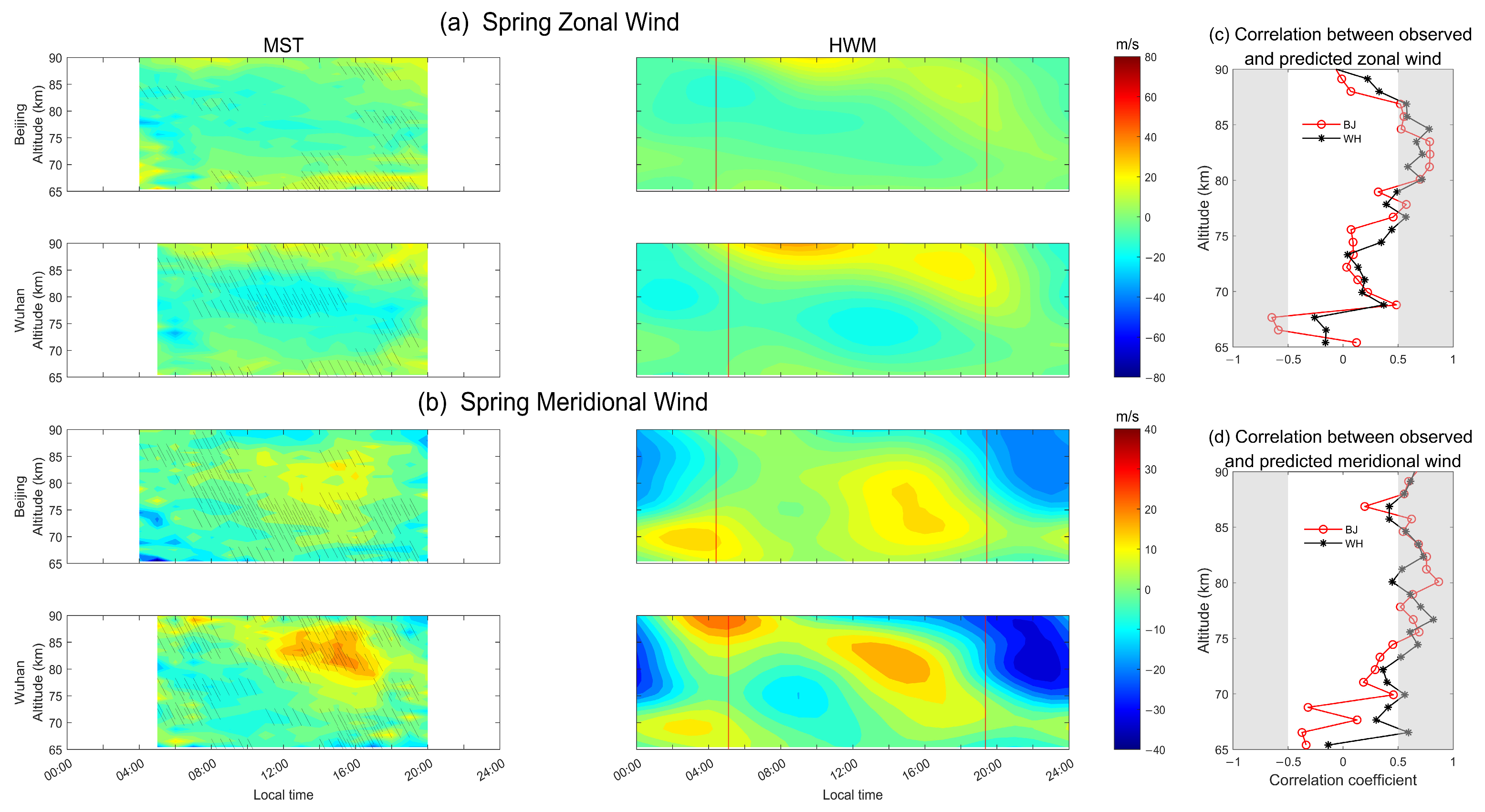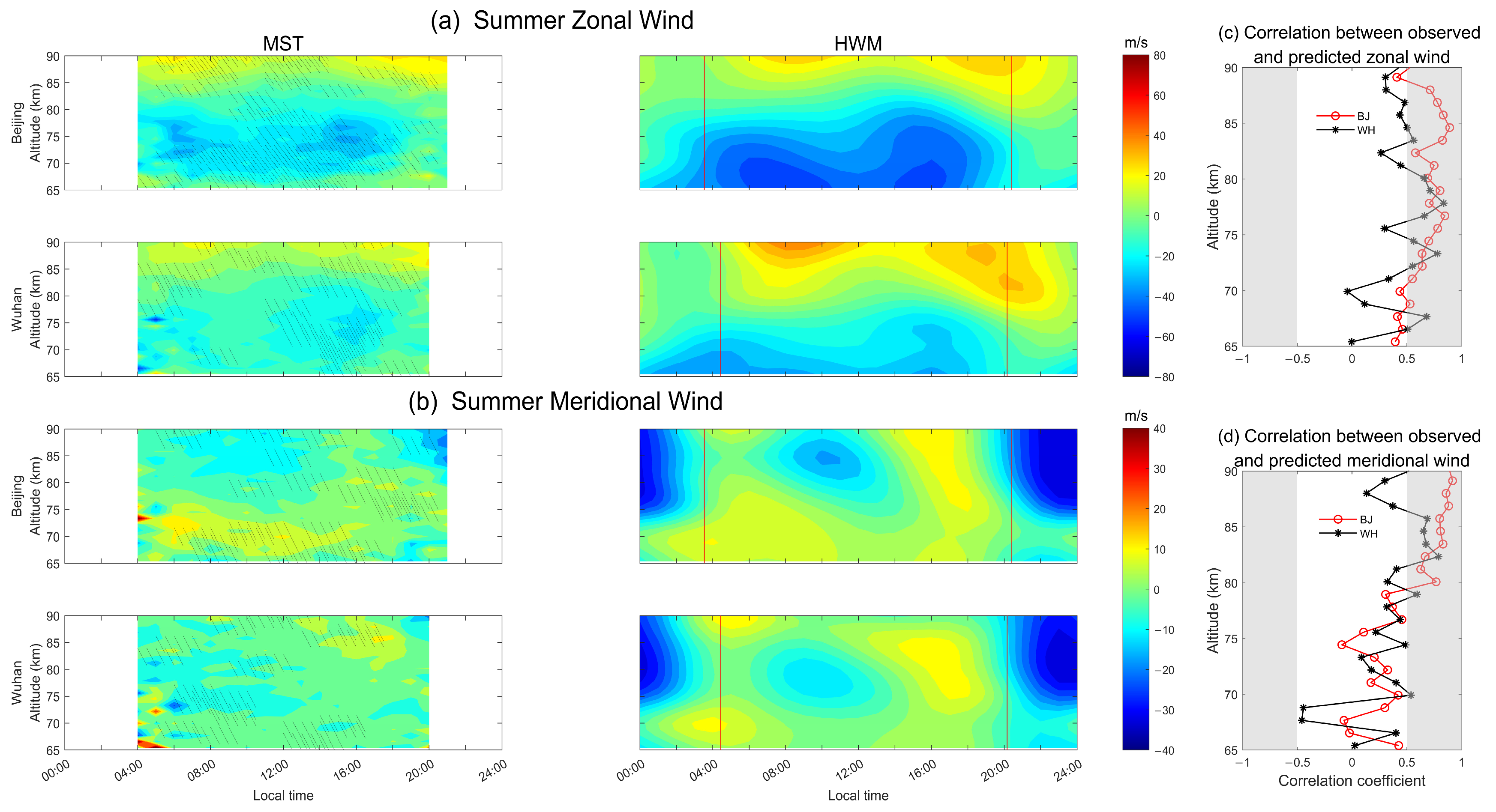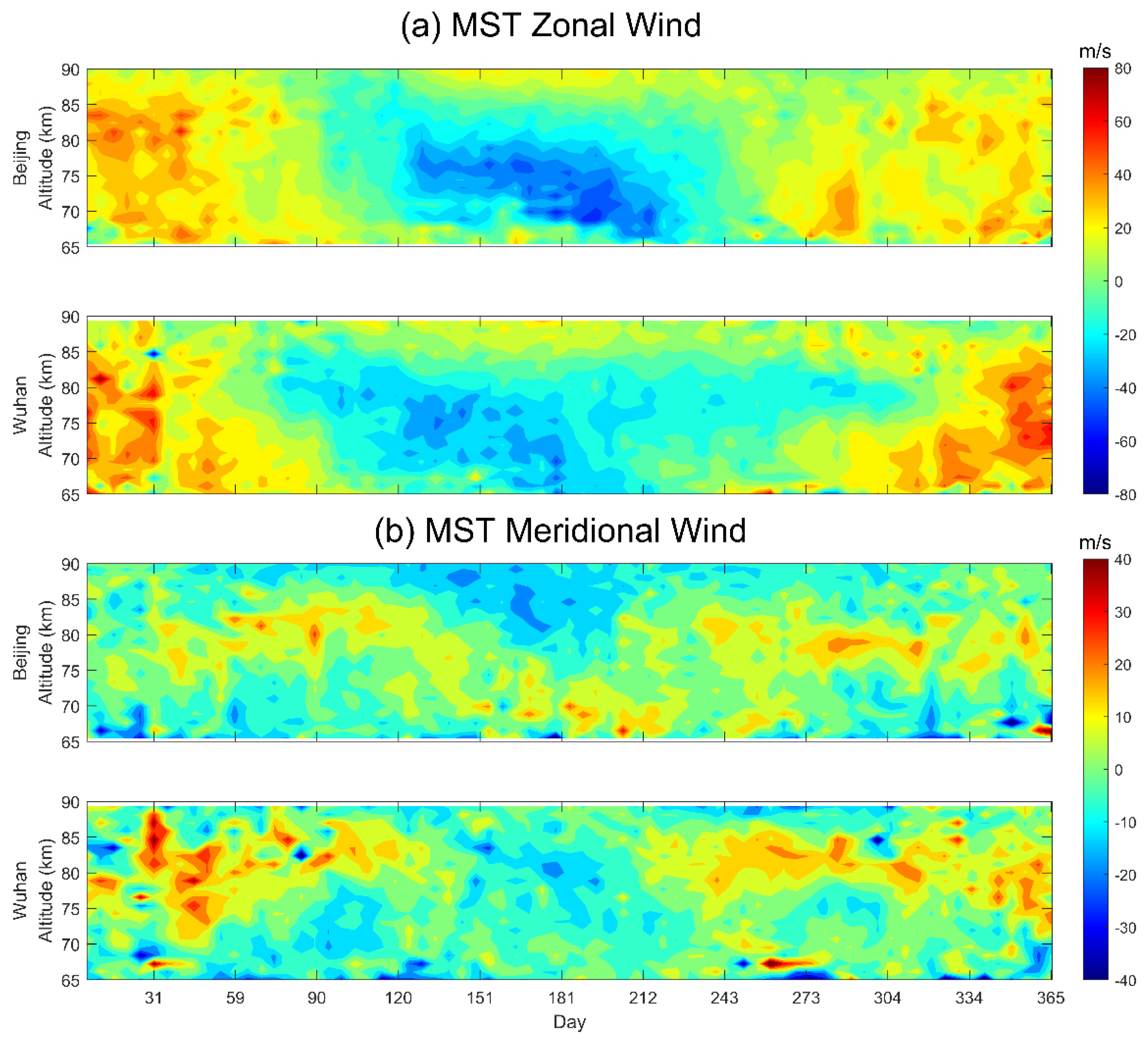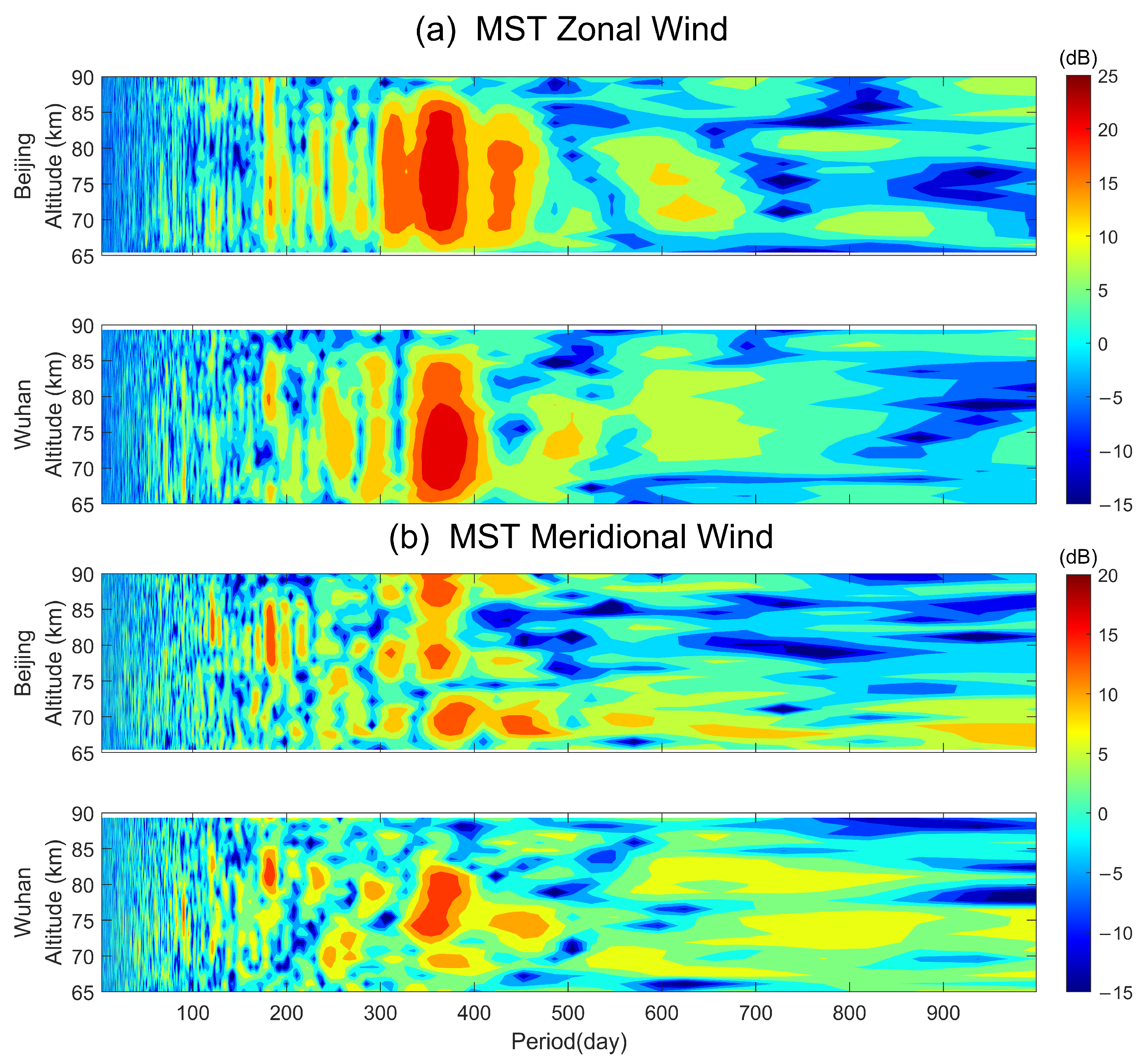Climatology of Midlatitude Mesospheric Zonal and Meridional Winds Observed by the Wuhan and Beijing MST Radars
Abstract
1. Introduction
2. Data and Methods
3. Results and Discussion
3.1. Diurnal Variation in the Average Winds During Different Seasons
3.2. Day-to-Day Variation of Zonal and Meridional Winds
3.3. Monthly Mean Wind Variations
3.4. Long Period Oscillations Detected in the Zonal and Meridional Winds
3.5. Amplitude and Phase Variations of AO and SAO in Zonal and Meridional Winds
3.6. The Effect of Solar Activity
4. Summary
Author Contributions
Funding
Data Availability Statement
Acknowledgments
Conflicts of Interest
References
- Dowdy, A.; Vincent, R.A.; Igarashi, K.; Murayama, Y.; Murphy, D.J. A comparison of mean winds and gravity wave activity in the northern and southern polar MLT. Geophys. Res. Lett. 2001, 28, 1475–1478. [Google Scholar] [CrossRef]
- Fritts, D.C.; Janches, D.; Iimura, H.; Hocking, W.K.; Bageston, J.V.; Leme, N.M.P. Drake Antarctic Agile Meteor Radar first results: Configuration and comparison of mean and tidal wind and gravity wave momentum flux measurements with Southern Argentina Agile Meteor Radar. J. Geophys. Res.-Atmos. 2012, 117, 17. [Google Scholar] [CrossRef]
- Kumar, G.K.; Hocking, A.K. Climatology of northern polar latitude MLT dynamics: Mean winds and tides. Ann. Geophys. 2010, 28, 1859–1876. [Google Scholar] [CrossRef]
- Lu, X.; Liu, A.Z.; Oberheide, J.; Wu, Q.; Li, T.; Li, Z.H.; Swenson, G.R.; Franke, S.J. Seasonal variability of the diurnal tide in the mesosphere and lower thermosphere over Maui, Hawaii (20.7°N,156.3°W). J. Geophys. Res.-Atmos. 2011, 116, 18. [Google Scholar] [CrossRef]
- Sandford, D.J.; Beldon, C.L.; Hibbins, R.E.; Mitchell, N.J. Dynamics of the Antarctic and Arctic mesosphere and lower thermosphere-Part 1: Mean winds. Atmos. Chem. Phys. 2010, 10, 10273–10289. [Google Scholar] [CrossRef]
- Sridharan, S.; Tsuda, T.; Gurubaran, S. Radar observations of long-term variability of mesosphere and lower thermosphere winds over Tirunelveli (8.7°N,77.8°E). J. Geophys. Res.-Atmos. 2007, 112, 12. [Google Scholar] [CrossRef]
- Wilhelm, S.; Stober, G.; Chau, J.L. A comparison of 11-year mesospheric and lower thermospheric winds determined by meteor and MF radar at 69 degrees N. Ann. Geophys. 2017, 35, 893–906. [Google Scholar] [CrossRef]
- Zhang, S.D.; Yi, F.; Hu, X. MF radar observation of mean wind and tides of winter mesopause (80–98 km) region over Wuhan (30°N,114°E). J. Atmos. Sol.-Terr. Phys. 2004, 66, 15–25. [Google Scholar] [CrossRef]
- Gong, Y.; Ma, Z.; Li, C.; Lv, X.; Zhang, S.; Zhou, Q.; Huang, C.; Huang, K.; Yu, Y.; Li, G. Characteristics of the quasi-16-day wave in the mesosphere and lower thermosphere region as revealed by meteor radar, Aura satellite, and MERRA2 reanalysis data from 2008 to 2017. Earth Planet. Phys. 2020, 4, 274–284. [Google Scholar] [CrossRef]
- Placke, M.; Stober, G.; Jacobi, C. Gravity wave momentum fluxes in the MLT-Part I: Seasonal variation at Collm (51.3°N, 13.0°E). J. Atmos. Sol.-Terr. Phys. 2011, 73, 904–910. [Google Scholar] [CrossRef]
- Zhao, G.X.; Liu, L.B.; Wan, W.X.; Ning, B.Q.; Xiong, J.G. Seasonal behavior of meteor radar winds over Wuhan. Earth Planets Space 2005, 57, 61–70. [Google Scholar] [CrossRef]
- Day, K.A.; Taylor, M.J.; Mitchell, N.J. Mean winds, temperatures and the 16- and 5-day planetary waves in the mesosphere and lower thermosphere over Bear Lake Observatory (42°N,111°W). Atmos. Chem. Phys. Discuss. 2011, 11, 30381–30418. [Google Scholar] [CrossRef]
- Tang, Q.; Zhou, Y.F.; Du, Z.T.; Zhou, C.; Qiao, J.D.; Liu, Y.; Chen, G.Y. A Comparison of Meteor Radar Observation over China Region with Horizontal Wind Model (HWM14). Atmosphere 2021, 12, 98. [Google Scholar] [CrossRef]
- Ma, Z.; Gong, Y.; Zhang, S.D.; Zhou, Q.H.; Huang, C.M.; Huang, K.M.; Dong, W.J.; Li, G.Z.; Ning, B.Q. Study of Mean Wind Variations and Gravity Wave Forcing Via a Meteor Radar Chain and Comparison with HWM-07 Results. J. Geophys. Res.-Atmos. 2018, 123, 9488–9501. [Google Scholar] [CrossRef]
- Sharma, A.K.; Gaikwad, H.P.; Ratnam, M.V.; Gurav, O.B.; Ramanjaneyulu, L.; Chavan, G.A.; Sathishkumar, S. Diurnal, monthly and seasonal variation of mean winds in the MLT region observed over Kolhapur using MF radar. J. Atmos. Sol.-Terr. Phys. 2018, 169, 91–100. [Google Scholar] [CrossRef]
- Zhou, B.; Xue, X.; Yi, W.; Ye, H.; Zeng, J.; Chen, J.; Wu, J.; Chen, T.; Dou, X. A comparison of MLT wind between meteor radar chain data and SDWACCM results. Earth Planet. Phys. 2022, 6, 451–464. [Google Scholar] [CrossRef]
- Franke, S.J.; Thorsen, D. Mean Winds and Tides in the Upper Middle Atmosphere at Urbana (40°N, 88°W) During 1991–1992. J. Geophys. Res. Part D Atmos. 1993, 98, 18607–18615. [Google Scholar] [CrossRef]
- Kishore, P.; Namboothiri, S.P.; Igarashi, K. Study of mesosphere lower thermosphere (MLT) mean winds over Yamagawa (31.2°N, 130.6°E) during 1996–1998. J. Geophys. Res.-Atmos. 2000, 105, 24863–24870. [Google Scholar] [CrossRef]
- Havnes, O.; Brattli, A.; Aslaksen, T.; Singer, W.; Latteck, R.; Blix, T.; Thrane, E.; Troim, J. First common volume observations of layered plasma structures and polar mesospheric summer echoes by rocket and radar. Geophys. Res. Lett. 2001, 28, 1419–1422. [Google Scholar] [CrossRef]
- Pfaff, R.; Holzworth, R.; Goldberg, R.; Freudenreich, H.; Voss, H.; Croskey, C.; Mitchell, J.; Gumbel, J.; Bounds, S.; Singer, W.; et al. Rocket probe observations of electric field irregularities in the polar summer mesosphere. Geophys. Res. Lett. 2001, 28, 1431–1434. [Google Scholar] [CrossRef]
- Hoppe, U.P.; Eriksen, T.; Thrane, E.V.; Blix, T.A.; Fiedler, J.; Lübken, F.J. Observations in the polar middle atmosphere by rocket-borne Rayleigh lidar:: First results. Earth Planets Space 1999, 51, 815–824. [Google Scholar] [CrossRef]
- Antonsen, T.; Havnes, O. On the detection of mesospheric meteoric smoke particles embedded in noctilucent cloud particles with rocket-borne dust probes. Rev. Sci. Instrum. 2015, 86, 12. [Google Scholar] [CrossRef]
- Ern, M.; Preusse, P.; Alexander, M.J.; Warner, C.D. Absolute values of gravity wave momentum flux derived from satellite data. J. Geophys. Res.-Atmos. 2004, 109, 17. [Google Scholar] [CrossRef]
- Ern, M.; Preusse, P.; Gille, J.C.; Hepplewhite, C.L.; Mlynczak, M.G.; Russell, J.M.; Riese, M. Implications for atmospheric dynamics derived from global observations of gravity wave momentum flux in stratosphere and mesosphere. J. Geophys. Res.-Atmos. 2011, 116, 24. [Google Scholar] [CrossRef]
- Alexander, M.J.; Gille, J.; Cavanaugh, C.; Coffey, M.; Craig, C.; Eden, T.; Francis, G.; Halvorson, C.; Hannigan, J.; Khosravi, R.; et al. Global estimates of gravity wave momentum flux from High Resolution Dynamics Limb Sounder observations. J. Geophys. Res.-Atmos. 2008, 113, 11. [Google Scholar] [CrossRef]
- Oberheide, J.; Lehmacher, G.A.; Offermann, D.; Grossmann, K.U.; Manson, A.H.; Meek, C.E.; Schmidlin, F.J.; Singer, W.; Hoffmann, P.; Vincent, R.A. Geostrophic wind fields in the stratosphere and mesosphere from satellite data. J. Geophys. Res.-Atmos. 2002, 107, 18. [Google Scholar] [CrossRef]
- Hocking, W.K. Strengths and limitations of MST radar measurements of middle-atmosphere winds. Ann. Geophys.-Atmos. Hydrospheres Space Sci. 1997, 15, 1111–1122. [Google Scholar] [CrossRef]
- Zhao, Z.Y.; Zhou, C.; Qing, H.Y.; Yang, G.B.; Zhang, Y.N.; Chen, G.; Hu, Y.G. Wuhan Atmosphere Radio Exploration (WARE) radar: System design and online winds measurements. Radio Sci. 2013, 48, 326–333. [Google Scholar] [CrossRef]
- Ratnam, M.V.; Rao, D.N.; Rao, T.N.; Thulasiraman, S.; Nee, J.B.; Gurubaran, S.; Rajaram, R. Mean winds observed with Indian MST radar over tropical mesosphere and comparison with various techniques. Ann. Geophys. 2001, 19, 1027–1038. [Google Scholar] [CrossRef][Green Version]
- Sheth, R.; Kudeki, E.; Lehmacher, G.; Sarango, M.; Woodman, R.; Chau, J.; Guo, L.; Reyes, P. A high-resolution study of mesospheric fine structure with the Jicamarca MST radar. Ann. Geophys. 2006, 24, 1281–1293. [Google Scholar] [CrossRef]
- Chen, G.; Cui, X.; Chen, F.L.; Zhao, Z.Y.; Wang, Y.; Yao, Q.; Wang, C.; Lü, D.R.; Zhang, S.D.; Zhang, X.X.; et al. MST Radars of Chinese Meridian Project: System Description and Atmospheric Wind Measurement. IEEE Trans. Geosci. Remote Sens. 2016, 54, 4513–4523. [Google Scholar] [CrossRef]
- Qiao, L.; Chen, G.; Zhang, S.D.; Yao, Q.; Gong, W.L.; Su, M.K.; Chen, F.L.; Liu, E.X.; Zhang, W.F.; Zeng, H.Y.; et al. Wuhan MST radar: Technical features and validation of wind observations. Atmos. Meas. Tech. 2020, 13, 5697–5713. [Google Scholar] [CrossRef]
- Nakamura, T.; Tsuda, T.; Fukao, S. Mean winds at 60–90 km observed with the MU radar (35°N). J. Atmos. Terr. Phys. 1996, 58, 655–660. [Google Scholar] [CrossRef]
- Latteck, R.; Strelnikova, I. Extended observations of polar mesosphere winter echoes over Andoya (69°N) using MAARSY. J. Geophys. Res.-Atmos. 2015, 120, 8216–8226. [Google Scholar] [CrossRef]
- Kumar, G.K.; Ratnam, M.V.; Patra, A.K.; Rao, V.; Rao, S.V.B.; Kumar, K.K.; Gurubaran, S.; Ramkumar, G.; Rao, D.N. Low-latitude mesospheric mean winds observed by Gadanki mesosphere-stratosphere- troposphere (MST) radar and comparison with rocket, High Resolution Doppler Imager (HRDI), and MF radar measurements and HWM93. J. Geophys. Res.-Atmos. 2008, 113, 12. [Google Scholar] [CrossRef]
- Ratnam, M.V.; Kumar, G.K.; Murthy, B.V.K.; Patra, A.K.; Rao, V.; Rao, S.V.B.; Kumar, K.K.; Ramkumar, G. Long-term variability of the low latitude mesospheric SAO and QBO and their relation with stratospheric QBO. Geophys. Res. Lett. 2008, 35, 5. [Google Scholar] [CrossRef]
- Tian, Y.F.; Lu, D.R. Comparison of Beijing MST radar and radiosonde horizontal wind measurements. Adv. Atmos. Sci. 2017, 34, 39–53. [Google Scholar] [CrossRef]
- Tian, Y.; Chen, Z.; Lyu, D. A dataset of Beijing MST radar horizontal wind fields at Xianghe Station in 2012. China Sci. Data 2021, 6, 1. [Google Scholar]
- Gong, W.; Zhou, X.; Chen, G.; Zhang, W. Mesosphere-Stratosphere-Troposphere radar dataset during 2012–2020 from Chongyang, Wuhan Station. China Sci. Data 2021, 6, 1. [Google Scholar] [CrossRef]
- Zhang, W.F.; Chen, G.; Zhang, S.D.; Gong, W.L.; Chen, F.L.; He, Z.Q.; Huang, K.M.; Wang, Z.H.; Li, Y.X. Statistical Study of the Midlatitude Mesospheric Vertical Winds Observed by the Wuhan and Beijing MST Radars in China. J. Geophys. Res.-Atmos. 2020, 125, 16. [Google Scholar] [CrossRef]
- Hedin, A.E.; Fleming, E.L.; Manson, A.H.; Schmidlin, F.J.; Avery, S.K.; Clark, R.R.; Franke, S.J.; Fraser, G.J.; Tsuda, T.; Vial, F.; et al. Empirical wind model for the upper, middle and lower atmosphere. J. Atmos. Terr. Phys. 1995, 58, 1421–1447. [Google Scholar] [CrossRef]
- Drob, D.P.; Emmert, J.T.; Crowley, G.; Picone, J.M.; Shepherd, G.G.; Skinner, W.; Hays, P.; Niciejewski, R.J.; Larsen, M.; She, C.Y.; et al. An empirical model of the Earth’s horizontal wind fields: HWM07. J. Geophys. Res.-Space Phys. 2008, 113, 18. [Google Scholar] [CrossRef]
- Emmert, J.T.; Drob, D.P.; Shepherd, G.G.; Hernandez, G.; Jarvis, M.J.; Meriwether, J.W.; Niciejewski, R.J.; Sipler, D.P.; Tepley, C.A. DWM07 global empirical model of upper thermospheric storm-induced disturbance winds. J. Geophys. Res.-Space Phys. 2008, 113, 16. [Google Scholar] [CrossRef]
- Drob, D.P.; Emmert, J.T.; Meriwether, J.W.; Makela, J.J.; Doornbos, E.; Conde, M.; Hernandez, G.; Noto, J.; Zawdie, K.A.; McDonald, S.E.; et al. An update to the Horizontal Wind Model (HWM): The quiet time thermosphere. Earth Space Sci. 2015, 2, 301–319. [Google Scholar] [CrossRef]
- Huba, J.D.; Ossakow, S.L.; Joyce, G.; Krall, J.; England, S.L. Three-dimensional equatorial spread F modeling: Zonal neutral wind effects. Geophys. Res. Lett. 2009, 36. [Google Scholar] [CrossRef]
- Kelly, M.A.; Comberiate, J.M.; Miller, E.S.; Paxton, L.J. Progress toward forecasting of space weather effects on UHF SATCOM after Operation Anaconda. Space Weather 2014, 12, 601–611. [Google Scholar] [CrossRef]
- Scargle, J.D. Studies in astronomical time series analysis. II-Statistical aspects of spectral analysis of unevenly spaced data. Astrophys. J. 1982, 263, 835–853. [Google Scholar] [CrossRef]
- Lomb, N.R. Least-squares frequency analysis of unequally spaced data. Astrophys. Space Sci. 1976, 39, 447–462. [Google Scholar] [CrossRef]
- Vincent, R.A.; Kovalam, S.; Fritts, D.C.; Isler, J.R. Long-term MF radar observations of solar tides in the low-latitude mesosphere: Interannual variability and comparisons with the GSWM. J. Geophys. Res.-Atmos. 1998, 103, 8667–8683. [Google Scholar] [CrossRef]
- Zhang, X.L.; Forbes, J.M.; Hagan, M.E.; Russell, J.M.; Palo, S.E.; Mertens, C.J.; Mlynczak, M.G. Monthly tidal temperatures 20–120 km from TIMED/SABER. J. Geophys. Res.-Space Phys. 2006, 111, 20. [Google Scholar] [CrossRef]
- Yu, Y.; Wan, W.X.; Ren, Z.P.; Xiong, B.; Zhang, Y.; Hu, L.H.; Ning, B.Q.; Liu, L.B. Seasonal variations of MLT tides revealed by a meteor radar chain based on Hough mode decomposition. J. Geophys. Res.-Space Phys. 2015, 120, 7030–7048. [Google Scholar] [CrossRef]
- Wilhelm, S.; Stober, G.; Brown, P. Climatologies and long-term changes in mesospheric wind and wave measurements based on radar observations at high and mid latitudes. Ann. Geophys. 2019, 37, 851–875. [Google Scholar] [CrossRef]
- Stober, G.; Baumgarten, K.; McCormack, J.P.; Brown, P.; Czarnecki, J. Comparative study between ground-based observations and NAVGEM-HA analysis data in the mesosphere and lower thermosphere region. Atmos. Chem. Phys. 2020, 20, 11979–12010. [Google Scholar] [CrossRef]
- Fritts, D.C.; Alexander, M.J. Gravity wave dynamics and effects in the middle atmosphere. Rev. Geophys. 2003, 41, 1003. [Google Scholar] [CrossRef]
- Suzuki, S.; Nakamura, T.; Ejiri, M.K.; Tsutsumi, M.; Shiokawa, K.; Kawahara, T.D. Simultaneous airglow, lidar, and radar measurements of mesospheric gravity waves over Japan. J. Geophys. Res.-Atmos. 2010, 115. [Google Scholar] [CrossRef]
- Matthias, V.; Dörnbrack, A.; Stober, G. The extraordinarily strong and cold polar vortex in the early northern winter 2015/2016. Geophys. Res. Lett. 2016, 43, 12287–12294. [Google Scholar] [CrossRef]
- Stober, G.; Matthias, V.; Jacobi, C.; Wilhelm, S.; Höffner, J.; Chau, J.L. Exceptionally strong summer-like zonal wind reversal in the upper mesosphere during winter 2015/16. Ann. Geophys. 2017, 35, 711–720. [Google Scholar] [CrossRef]
- Friedman, J.S. Tropical mesopause climatology over the Arecibo Observatory. Geophys. Res. Lett. 2003, 30, 4. [Google Scholar] [CrossRef]
- Laskar, F.I.; Chau, J.L.; St-Maurice, J.P.; Stober, G.; Hall, C.M.; Tsutsumi, M.; Hoffner, J.; Hoffmann, P. Experimental Evidence of Arctic Summer Mesospheric Upwelling and Its Connection to Cold Summer Mesopause. Geophys. Res. Lett. 2017, 44, 9151–9158. [Google Scholar] [CrossRef]
- Hu, X.; Zhang, X.; Igarashi, K.; Zhang, D. A preliminary comparison of observations with MF radars in Wuhan and Yamagawa at 30–31 N. J. Atmos. Sol.-Terr. Phys. 2006, 68, 1036–1042. [Google Scholar] [CrossRef]
- Manson, A.H.; Meek, C.E.; Hall, C.M.; Nozawa, S.; Mitchell, N.J.; Pancheva, D.; Singer, W.; Hoffmann, P. Mesopause dynamics from the scandinavian triangle of radars within the PSMOS-DATAR Project. Ann. Geophys. 2004, 22, 367–386. [Google Scholar] [CrossRef]
- Jacobi, C.; Hoffmann, P.; Liu, R.Q.; Merzlyakov, E.G.; Portnyagin, Y.I.; Manson, A.H.; Meek, C.E. Long-term trends, their changes, and interannual variability of Northern Hemisphere midlatitude MLT winds. J. Atmos. Sol.-Terr. Phys. 2012, 75–76, 81–91. [Google Scholar] [CrossRef]
- Chau, J.L.; Hoffmann, P.; Pedatella, N.M.; Matthias, V.; Stober, G. Upper mesospheric lunar tides over middle and high latitudes during sudden stratospheric warming events. J. Geophys. Res.-Space Phys. 2015, 120, 3084–3096. [Google Scholar] [CrossRef]
- Mbatha, N.; Sivakumar, V.; Malinga, S.B.; Bencherif, H.; Pillay, S.R. Study on the impact of sudden stratosphere warming in the upper mesosphere-lower thermosphere regions using satellite and HF radar measurements. Atmos. Chem. Phys. 2010, 10, 3397–3404. [Google Scholar] [CrossRef]
- Stray, N.H.; Orsolini, Y.J.; Espy, P.J.; Limpasuvan, V.; Hibbins, R.E. Observations of planetary waves in the mesosphere-lower thermosphere during stratospheric warming events. Atmos. Chem. Phys. 2015, 15, 4997–5005. [Google Scholar] [CrossRef]
- Ma, Z.; Gong, Y.; Zhang, S.D.; Zhou, Q.H.; Huang, C.M.; Huang, K.M.; Yu, Y.; Li, G.Z.; Ning, B.Q.; Li, C. Responses of Quasi 2 Day Waves in the MLT Region to the 2013 SSW Revealed by a Meteor Radar Chain. Geophys. Res. Lett. 2017, 44, 9142–9150. [Google Scholar] [CrossRef]
- Zhou, B.Z.; Yi, W.; Xue, X.H.; Ye, H.L.; Zeng, J.; Li, G.Z.; Tsutsumi, M.; Gulbrandsen, N.; Chen, T.D.; Dou, X.K. Impact of sudden stratospheric warmings on the neutral density, temperature and wind in the MLT region. Front. Astron. Space Sci. 2023, 10, 9. [Google Scholar] [CrossRef]
- Portnyagin, Y.I.; Merzlyakov, E.G.; Solovjova, T.V.; Jacobi, C.; Kurschner, D.; Manson, A.; Meek, C. Long-term trends and year-to-year variability of mid-latitude mesosphere/lower thermosphere winds. J. Atmos. Sol.-Terr. Phys. 2006, 68, 1890–1901. [Google Scholar] [CrossRef]
- Gong, Y.; Zhou, Q.H.; Zhang, S.D. Atmospheric tides in the low-latitude E and F regions and their responses to a sudden stratospheric warming event in January 2010. J. Geophys. Res.-Space Phys. 2013, 118, 7913–7927. [Google Scholar] [CrossRef]
- Jia, M.J.; Xue, X.H.; Gu, S.Y.; Chen, T.D.; Ning, B.Q.; Wu, J.F.; Zeng, X.Y.; Dou, X.K. Multiyear Observations of Gravity Wave Momentum Fluxes in the Midlatitude Mesosphere and Lower Thermosphere Region by Meteor Radar. J. Geophys. Res.-Space Phys. 2018, 123, 5684–5703. [Google Scholar] [CrossRef]
- Yi, W.; Xue, X.H.; Reid, I.M.; Murphy, D.J.; Hall, C.M.; Tsutsumi, M.; Ning, B.Q.; Li, G.Z.; Vincent, R.A.; Chen, J.S.; et al. Climatology of the mesopause relative density using a global distribution of meteor radars. Atmos. Chem. Phys. 2019, 19, 7567–7581. [Google Scholar] [CrossRef]
- Rao, N.V.; Tsuda, T.; Riggin, D.M.; Gurubaran, S.; Reid, I.M.; Vincent, R.A. Long-term variability of mean winds in the mesosphere and lower thermosphere at low latitudes. J. Geophys. Res.-Space Phys. 2012, 117, 16. [Google Scholar] [CrossRef]
- Namboothiri, S.P.; Kishore, P.; Igarashi, K.; Nakamura, T.; Tsuda, T. MF radar observations of mean winds over Yamagawa (31.2° N, 130.6° E) and Wakkanai (45.4° N, 141.7° E). J. Atmos. Sol.-Terr. Phys. 2000, 62, 1177–1187. [Google Scholar] [CrossRef]
- Keuer, D.; Hoffmann, P.; Singer, W.; Bremer, J. Long-term variations of the mesospheric wind field at mid-latitudes. Ann. Geophys. 2007, 25, 1779–1790. [Google Scholar] [CrossRef]
- Jacobi, C.; Kürschner, D. Long-term trends of MLT region winds over Central Europe. Phys. Chem. Earth. 2006, 31, 16–21. [Google Scholar] [CrossRef]
- Qian, L.Y.; Jacobi, C.; McInerney, J. Trends and Solar Irradiance Effects in the Mesosphere. J. Geophys. Res.-Space Phys. 2019, 124, 1343–1360. [Google Scholar] [CrossRef]
- Middleton, H.R.; Mitchell, N.J.; Muller, H.G. Mean winds of the mesosphere and lower thermosphere at 52° N in the period 1988–2000. Ann. Geophys. 2018, 20, 81–91. [Google Scholar] [CrossRef][Green Version]
- Pokhotelov, D.; Becker, E.; Stober, G.; Chau, J.L. Seasonal variability of atmospheric tides in the mesosphere and lower thermosphere: Meteor radar data and simulations. Ann. Geophys. 2018, 36, 825–830. [Google Scholar] [CrossRef]











| MST Radar | Geographic Location | Frequency | Data Used in this Study (Number of Observed Profiles) | Altitude Resolution | Time Resolution |
|---|---|---|---|---|---|
| Beijing (BJ) | 39.75°N, 116.96°E | 50 MHz | 01/01/2012–31/12/2021 (188,520) | 1.13 km | 30 min |
| Wuhan (WH) | 29.51°N, 114.13°E | 53.8 MHz | 01/01/2012–31/12/2021 (158,781) | (2012–2013) 1.13 km (2014–2015) 1.18 km (2016–2017) 1.17 km (2018–2021) 1.16 km | 30 min |
Disclaimer/Publisher’s Note: The statements, opinions and data contained in all publications are solely those of the individual author(s) and contributor(s) and not of MDPI and/or the editor(s). MDPI and/or the editor(s) disclaim responsibility for any injury to people or property resulting from any ideas, methods, instructions or products referred to in the content. |
© 2025 by the authors. Licensee MDPI, Basel, Switzerland. This article is an open access article distributed under the terms and conditions of the Creative Commons Attribution (CC BY) license (https://creativecommons.org/licenses/by/4.0/).
Share and Cite
Zhang, W.; Lu, X.; Chen, G.; Gong, W.; Chang, L. Climatology of Midlatitude Mesospheric Zonal and Meridional Winds Observed by the Wuhan and Beijing MST Radars. Remote Sens. 2025, 17, 806. https://doi.org/10.3390/rs17050806
Zhang W, Lu X, Chen G, Gong W, Chang L. Climatology of Midlatitude Mesospheric Zonal and Meridional Winds Observed by the Wuhan and Beijing MST Radars. Remote Sensing. 2025; 17(5):806. https://doi.org/10.3390/rs17050806
Chicago/Turabian StyleZhang, Weifan, Xun Lu, Gang Chen, Wanlin Gong, and Li Chang. 2025. "Climatology of Midlatitude Mesospheric Zonal and Meridional Winds Observed by the Wuhan and Beijing MST Radars" Remote Sensing 17, no. 5: 806. https://doi.org/10.3390/rs17050806
APA StyleZhang, W., Lu, X., Chen, G., Gong, W., & Chang, L. (2025). Climatology of Midlatitude Mesospheric Zonal and Meridional Winds Observed by the Wuhan and Beijing MST Radars. Remote Sensing, 17(5), 806. https://doi.org/10.3390/rs17050806






